#Japanese folktales
Explore tagged Tumblr posts
Text

Here's my pencil sketch for this months Bad Apple artists art auction.
The theme is "The Mythology of Japan". With my enamle pin project I've worked with japanese folklore as theme. I've picked to draw one of my favourites the kitsune.
Can't wait to share the finished painting!
#sylvia strijk#artists on tumblr#my art#fantasy art#concept sketch#sketchbook#pencil sketch#kitsune#fox girl#Fox art#Youkai#japanese folktales#fairy tale#demon girl#magical girl#bad apple artist collective
61 notes
·
View notes
Text
Fairytales in anime and manga
Yonimo Osoroshii Grimm Douwa / Otona no Douwa / Otona no Dowa series: Yonimo Oroshii Grimm Dowa. (The truly horrible Grimm fairytales) A series of OVA reimagining three European fairytales in different styles - but all as horror stories. (This mini-series is completed by another set of OVA reimagining three Japanese folktales in a similar manner, Yonimo Osoroshii Nihon Mukashibanashi, The truly horrible Japanese folktales. Together they form the Otona no Douwa series - not to be confused with the various hentai mangas of the same name since "Otona no Dowa" means "Fairytales for adults")






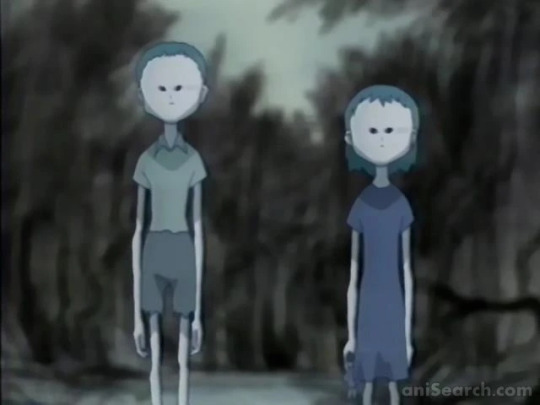
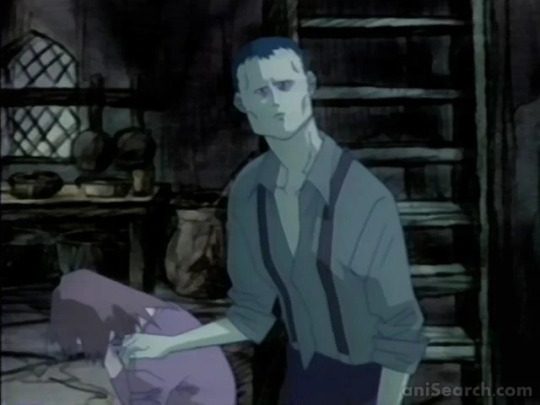




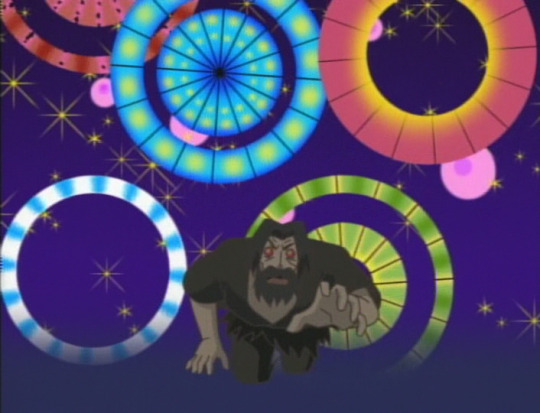





#fairytale anime#horror anime#dark fairytale#fairytale horror#otona no douwa#otona no dowa#yonimo osoroshii grimm douwa#yonimo osoroshii nihon mukashibanashi#japanese folktales#folk horror
7 notes
·
View notes
Text

昔話 (2023)
3 notes
·
View notes
Text

A HORROR FAVORITE OF BOTH HIDEO KOJIMA & GUILLERMO DEL TORO -- DON'T PASS THIS ONE UP IN OCTOBER.
PIC INFO: Spotlight on "Onibaba" (lit. "Demon hag"), also titled "The Hole," a 1964 Japanese historical drama and horror film written and directed by Kaneto Shindō. The film was re-released on Blu-ray by the Criterion Collection as Spine #226 using the DVD master on October 5, 2021.
OVERVIEW: "Deep in the windswept marshes of war-torn medieval Japan, an impoverished older woman and her daughter-in-law murder lost samurai and sell their belongings for the most meager of sustenance. When a bedraggled neighbor returns from battle, lust, jealousy, and rage threaten to destroy the trio’s tenuous existence, before an ominous, ill-gotten demon mask seals their horrifying fate. Driven by primal emotions, dark eroticism, a frenzied score by Hikaru Hayashi, and stunning images both lyrical and macabre, Kaneto Shindo’s chilling folktale "Onibaba" conjures a nightmarish vision of humankind’s deepest desires and impulses."
-- CRITERION COLLECTION, c. 2021
Source: www.criterion.com/films/665-onibaba.
#Onibaba#Onibaba 1964#Kaneto Shindo#Criterion#Demon Hag#Demon Hag 1964#Noh Theatre#Noh Mask#Japanese Films#Japanese folktales#Horror Art#Shindo Kaneto#Japanese folklore#Criterion Collection#Horror#Cover Art#Onibaba 1964 Film#Graphic Art#60s Movies#60s Cinema#Japanese Cinema#Japanese horror#Onibaba Film#DVD Box Art#1964#Onibaba Movie#Japanese Movies#Noh
2 notes
·
View notes
Text
Ooka the Wise and the Two Women
A Tale of Justice and Wisdom from Japan One day, a case concerning a baby boy came to Ooka’s court. Two women claimed to be the boy’s mother, and Ooka was faced with the challenge of deciding which woman was telling the truth. Both women had recently come to Yedo (old Tokyo), and so there were no witnesses to support either claim. Thinking that the child himself would be sure to recognize his own…

View On WordPress
#Japan#Japanese folktales#Japanese justice#judge#judge ooka#justice#Ooka Eichizen#Ōoka Tadasuke#samurai#Tokugawa shogunate
0 notes
Text
Given what happened to Urashima Tarō, they may not be entirely wrong
Mermaids not pruning but noticing that Humans do and coming to the incorrect conclusion that the sea steals their youth and that’s why Humans don’t swim down with them
65 notes
·
View notes
Text
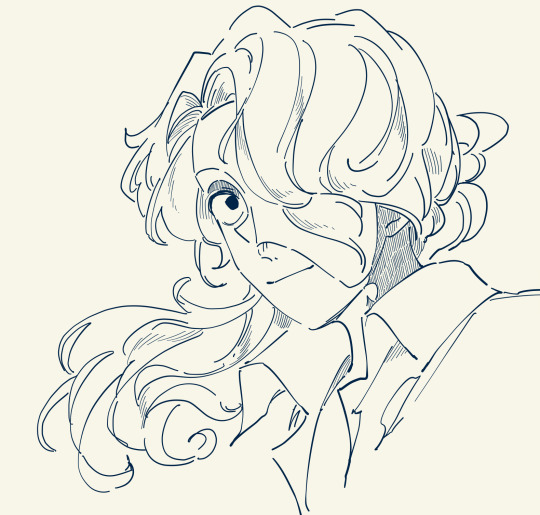
Need to write a 4000 word essay and take a neurobio final before I’m done with the term and both are due Thursday so we’re going back to the procrastination doodles again
#spade pirate sabo au#sabo#my essay is kind of a banger!!#it’s a Japanese literature class#something something the maintenance of systems of power and belief#through the idea that sight and knowledge are power#which interfaces interestingly with the supernatural which by virtue of its unknowability has some inherent value greater than mortals#and how these folktales are a way for the working class common folk to fantasize about the higher class and nobility through storytelling
467 notes
·
View notes
Text
How a mythical catfish became the symbol of the Japanese working class: the Namazu

In 1855, a colossal earthquake hit the city of Tokyo, which at the time was called Edo. The clean-up and rebuilding efforts of this disaster coincided with a steep rise in pamphlets, booklets and prints featuring a giant catfish: this is because in Japanese mythology, the giant catfish Namazu is the great bringer of earthquakes. It was also called Jishin no Uo, the Earthquake Fish.
The Namazu is a giant, monstrous catfish who lives deep within the Earth. When he trashes about, earthquakes plague the lands above and cause great suffering to humans. The Namazu is usually depicted as either a colossal catfish or a humanoid creature with the head of a catfish but still wearing human clothes. In some cases, it is portrayed as a dragon with the head of a catfish.
The Kashima deity – who is worshipped at the Kashima shrine in Ibaraki prefecture – managed to defeat the monster and keeps it under control with his sword. Supposedly, this god is still there, and whenever he falters or lowers his guard, or when he falls asleep, the Namazu is able to thrash around it and cause an earthquake. In another version, the monster is pinned under a giant rock, the top of which (the ‘Kanameishi’) is visible at the Kashima shrine. It is believed that the god pushes down on this stone to prevent his enemy from moving.

And yet, despite this calamitous catfish being a bringer of suffering and despair, there are texts from this period that praise the Namazu and welcome it. Some of these prints feature the creature singing a ‘yo-naoshi chobokure’ song, which consoles the hearer by telling them to ‘rejoice and be happy, for you will become rich overnight!’ In some images, the Namazu is even vomiting gold and silver coins while fighting the god who restrains it.
This association between earthquakes and wealth seems contradictory at first, but there is a reason for it: those who have the largest properties have more to lose in an earthquake. The manors of nobles and rich people, as well as the storehouses of wealthy merchants, were thoroughly destroyed in the disaster. In fact, by coincidence, residences of the elite seemed to have been disproportionally damaged whereas commoner neighbourhoods got off with (relatively!) few casualties.
More importantly, the rebuilding efforts allowed a massive redistribution of wealth to those who were actually rebuilding: the carpenters, plasters, roofers and other workers of Edo reaped record profits in the years following the great quake, as their trades were in higher demand than ever before. Similarly, merchants who dealt in construction materials saw demand for their products skyrocket. In an ironic twist of fate, the Namazu became a political symbol of the working class, and of social rectification.

In fact, some illustrators in this era were less subtle and made images (now in the Tokyo and Fujisawa University collections) of the Namazu violently shaking the rich until they vomited or even defecated money. I find this really interesting because these are quite literally political cartoons, just from a distant time and place. In one of the prints from the Fujisawa collection, the text tells how the rich suffered from ‘choja kane no byo’ or ‘money disease’ and the Namazu, now hailed as an earthquake god, forcibly takes away their hoarded wealth and distributes it to the builders. As far as allegories go, you can’t get less subtle than that.
Nevertheless, the Namazu remained a symbol of earthquakes and that association still exists today. The Pokémon Whiscash, for example, is based on the mythical Namazu. In Legend of Zelda: A Link to the Past, a giant catfish gives the player the ‘quake medallion’. The Namazu remains a somewhat common sight in Japanese pop culture.
Sources: Ouweland, C., 1964, Namazu-e and their themes: an interpretative approach to some aspects of Japanese folk religion, Brill Archive, 271 pp. Smits, G., The Ansei Edo Earthquake and Catfish Prints, essay, University of British Columbia. Steele, M. W., Apocalypse Now: an alternate view of the Bakumatsu years, essay, University of British Columbia. (image 1: An 1855 woodblock print depicting the Namazu fighting the sword wielding god while the rich pour money onto the working class. Image taken from World History Encyclopedia) (image 2: an 1855 woodblock print depicting the Namazu, dressed as a monk, chanting the nenbutsu in an attempt to appease the people who died in the earthquake, as their souls look down from above. Source: Hachiro Yuasa Memorial Museum) (image 3: the Namazu, now with a human body, is attacked by courtesans and rich merchants while construction workers (dressed in black) attempt to stop them. Image source: University of British Columbia Library)
#Japanese mythology#mythical creatures#catfish#monsters#creatures#world mythology#folklore#folktales#Japan
48 notes
·
View notes
Text


A photo of what looks like a dragon on Mt Fuji believed to be taken on Nov 28, 2024 circulated around Japanese social media, SNS.
Japanese point out the uncanny resemblance to painting of a dragon on Mt Fuji by an ukiyo-artist during Edo Period named, Katsushika Hokusai, known for his iconic painting of Kanagawa Wave.
According to Japanese folktales, legend has it that after the Dragon appeared, it means Mt Fuji will erupt again. Which is scary when you think about it. So I hope not! PLEASE DON'T. 😱😂
I think it's interesting when you realized that some old paintings are not purely fantasy or product of their own imagination, the artists simply paint WHAT IT LOOKS LIKE to them when they saw it.
When legend say it will erupt after the dragon appeared, it might be the smoke or gas that they see which looks like a dragon. As volcano usually erupts after the smoke or gas appears.
So I hope that is not a smoke or gas, and just clouds. I only know about the legend after watching a comedy mystery jdrama, starring Masami Nagasawa, who talks about it. 😂
Photo by 姫野雪菜. Painting by Shoga.
Japan Meteorological Agency : Volcanic Activities
#mount fuji#mt fuji#fujisan#japan#japanese dragon#dragon#japanese folktale#japanese legend#katsushika hokusai#ukiyoe#kanagawa wave#edo period
44 notes
·
View notes
Text
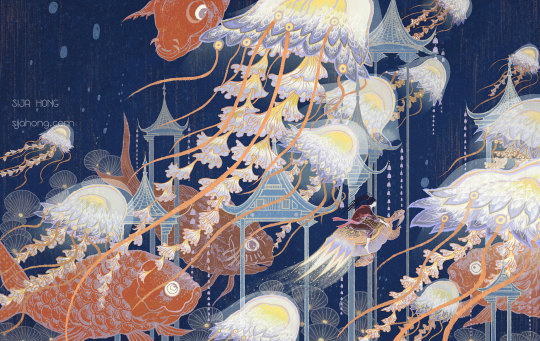
浦島太郎の物語I (1 of 2) - Sija Hong
#浦島太郎の物語I#The story of Taro Urashima I#Sija Hong#Urashimako#travelers#jellyfish#Japanese#folktales#fantasy art#digital art
108 notes
·
View notes
Text






#the beatles#youtube comments#yoko ono#john lennon#he’s a real one#60s#70s#the rolling stones#fandoms#n word#the cringe is real#lindsay ellis#john please stop#it’s not her fault#i’ll defend yoko ono until the day i die#japanese folktale#matpat#paul mccartney#ao3#it’s not abnormal it’s love john#twitter#performance art
34 notes
·
View notes
Text
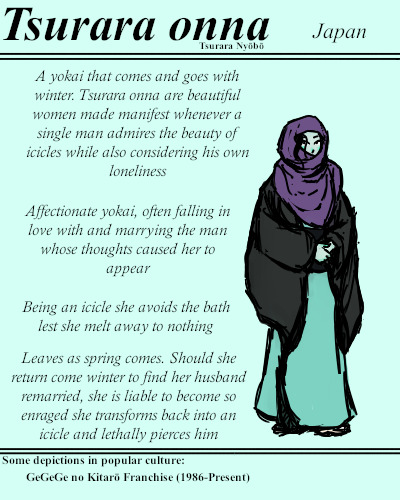
A yokai that expects only faithfulness in love, even should she disappear without a word. Surprisingly warm-hearted despite her chilling nature.
#BriefBestiary#bestiary#digital art#fantasy#folklore#legend#myth#mythology#folktale#yokai#youkai#tsurara onna#tsurara nyōbō#icicle yokai#icicle woman#winter yokai#winter folklore#japanese folklore#japanese legend#japanese folktale
55 notes
·
View notes
Note
Noppera-Bo from Japanese folktales is an avatar of the stranger
noppera-bo from japanese folklore is an avatar of the stranger!


#tma#the magnus archives#nopperabo#noppera-bo#japanese folklore#japanese folktale#the stranger#your fave is an avatar
11 notes
·
View notes
Text
Long ago there was a place here called Takashiba Slope. A man from this area was sent to be a fire keeper for the palace’s fire hut. Once, when he was sweeping the imperial garden, he murmured to himself this complaint, ‘Why, oh why, have I met such a cruel fate? On the seven, on the three, sake vats of my home country lie straight handles of gourd ladles. South blows the wind, they drift to the north; North blows the wind, they drift to the south; West blows the wind, they drift to the east; East blows the wind, they drift to the west. None of which I see, just stuck here like this.’ At that moment, the emperors’s daughter (a much treasured person) was standing by herself at the edge of the bamboo blinds. Leaning against a pillar, she gazed out and was much moved by the serving man’s solitary complaint. What kind of gourd ladles were they? How did they drift one way and another? Becoming curious about this, she raised the bamboo blinds and summoned him, ‘You over there, come here.‘ When, full of trepidation, he came over beside the balustrade, she ordered him, ‘That which you just spoke, repeat it one more time for me.’ And so he repeated the words about the sake vats one more time. At this point, she ordered him, ‘Take me there and show me these things; I have a reason for saying so.’ Although he felt terribly afraid, (was this not something fated to happen?), he carried her on his back down to his home country. Now, thinking that surely they would be followed, that night he sat down the princess at the foot of the Seta Bridge and destroyed a whole section of it. Leaping back over it, he hoisted the princess on his back, and seven days and seven nights later, they arrived in the province of Musashi. The emperor and empress were distraught when they realized the princess had disappeared. When they searched for her, someone said, ‘There is a manservant, a fire keeper from the province of Musashi, who flew away with a very fragrant bundle around his neck.’ When they inquired after this manservant, he was gone. Surely he must have returned to his home province, they thought. But when the members of the court’s envoy expedition who were chasing after him found the Seta Bridge broken, they could not continue. Three months later, when they arrived in Musashi and found this manservant, the princess summoned the imperial envoy into her presence and made the following pronouncement: ‘I, for it seems to have been meant to be, became very curious about this man’s home, and when I said, “Take me there,” he brought me here. I find it very pleasant here. If this man is punished for having committed a crime, then what about me? For me to have sought out this country must be a fate determined in a former existence. Quickly return to the court and report what has happened.’ There was nothing he could say, so the envoy went back up to the capital and reported to the emperor, ‘It is such and so.’ It was useless to say anything; even if this man had committed a crime, it was not as though the princess could be removed now and brought back to the capital. So, the emperor issued a proclamation putting the Takeshiba man in charge of Musashi Province for as long as he lived and exempted the province from public taxes and corvee duties, in effect making the princess the patron of the province. At that time, the man’s house was converted to a palace. Now, this house where the princess lived was turned into a temple after she passed away, and that is why it is called Takashiba Temple. All the children born to the princess were given the surname Musashi, just like that. From that time forward, it is said that the imperial palace fires were attended by women.
A local folktale retold in the Sarashina Nikki by the then-13yo author.
footnotes under the cut:

8 notes
·
View notes
Text
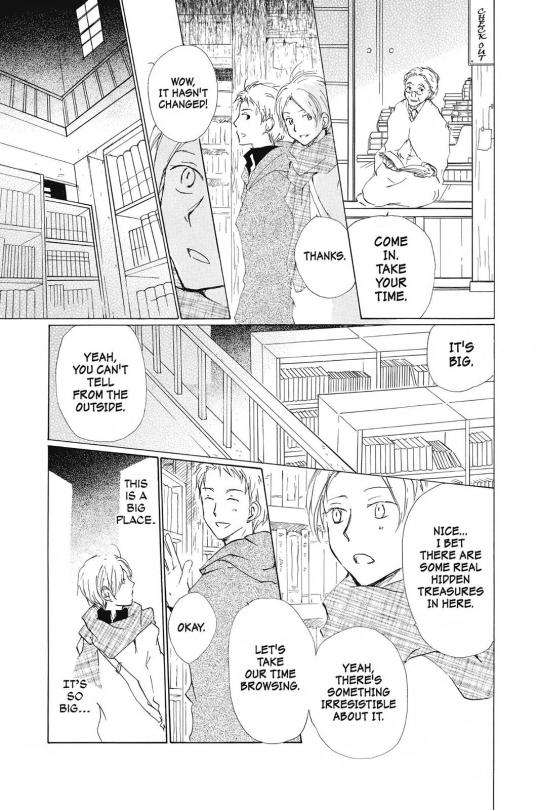
I thought s7 episode 4's pacing was a bit weird, so I decided to check the manga and see if it was paced better and it is largely, and there are some cute character moments I wanted to post. But I wanted to say what I wanted to say when I saw the episode:
I CANNOT believe it took 83 chapters/7 seasons for us to learn Natsume and Kitamoto are the kind of book nerds who will get excited discovering a used book store and say stuff like "I bet there are hidden treasures here" and "wow it's so irresistible" THIS IS IMPORTANT INFO YUKI MIDORIKAWA MA'AM i needed to know this earlier!
I guess now that I think of it there have been times Natsume's just reading somewhere, like the time he got nailed in the head with a ball. And I can see how liking reading could have come about, lonely children love the sweet embrace of the library (source: was a lonely child who basically lived at my school library).
But yeah, Kitamoto's just a big ol' nerd. We learn what kind of books he likes in this chapter. But I'm curious what books Natsume likes? The people need to know.
#I feel like he'd probably stay away from fantasy#as a child I'm betting he studiously avoided it because it would make him “worse”.#though once he started getting more comfortable with yokai I can see him starting to read some old folktales#just so he could understand his friends <3 and also see what other people got wrong#mmmm what would his genre be. nonfiction maybe?#like just random subjects with the hope it will give him things to discuss with people and then he never actually talks about them#I could see him liking historical fiction or just general contemporary stories#oh he probably likes books about cats. which is good if you're reading contemporary japanese literature. they're everywhere.#nev reads natsume's book of friends
8 notes
·
View notes
Text

My Happy Marriage Receives Autumn Visual
Yen Press describes the plot as:
IS THIS MARRIAGE A BLESSING? OR A CURSE?
Born talentless to a noble family famous for their supernatural abilities, Miro Saimori is forced into an existence of servitude by his abusive stepfather. When Miro finally comes of marriageable age, though, his hopes of being whisked away to a better life crumble after he discovers his fiancée’s identity: Kiyomi Kudou, a commander apparently so cold and cruel that her previous would-be bridegrooms all fled within three days of their engagements. With no home to return to, Miro resigns himself to his fate—and soon finds that his pale and beautiful wife-to-be is anything but the monster he expected. As they slowly open their hearts to each other, both realize the other may be their chance at finding true love and happiness.
@mochiette
@sleepy-edits
@like-fairy-tales
@laurenillustrated
@earlgreybocchan
@sallyb-sin
@tetrix-anime
@cinderello-blog
@ludoviccapel
@teenageoaffireknight
@soothedcerberus
@charlottecors
@ur-daily-inspiration
@a-titty-ninja
@sol-em-gemeos
@crimsonblack2
@deathcomequickly
@ultimateanna
@hidheim
@royaltystudios
#my happy marriage#funimation#anime#care characters#mythology#fairy tales#folklore#watashi no shiawase na kekkon#miro saimori#kiyomi kudou#autumn colors#fall autumn#autumn#the duke of death and his maid#the duke of death and his black maid#shinigami bocchan to kuro maid#shinigami bocchan#japanese folktale#viktor x alice#viktor#alice lendrott#cinderella#cinderello#dream bright viktor#i care alice#anime and manga#anime art#manga art#anime style
7 notes
·
View notes